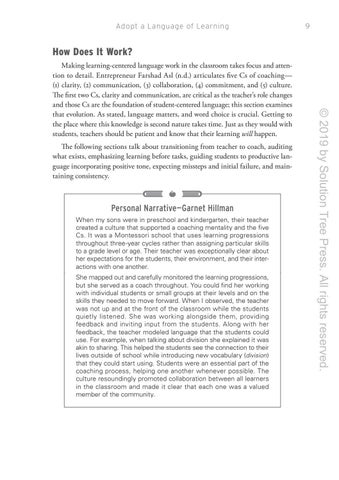Adopt a Language of Learning
9
How Does It Work?
The following sections talk about transitioning from teacher to coach, auditing what exists, emphasizing learning before tasks, guiding students to productive language incorporating positive tone, expecting missteps and initial failure, and maintaining consistency.
Personal Narrative—Garnet Hillman When my sons were in preschool and kindergarten, their teacher created a culture that supported a coaching mentality and the five Cs. It was a Montessori school that uses learning progressions throughout three-year cycles rather than assigning particular skills to a grade level or age. Their teacher was exceptionally clear about her expectations for the students, their environment, and their interactions with one another. She mapped out and carefully monitored the learning progressions, but she served as a coach throughout. You could find her working with individual students or small groups at their levels and on the skills they needed to move forward. When I observed, the teacher was not up and at the front of the classroom while the students quietly listened. She was working alongside them, providing feedback and inviting input from the students. Along with her feedback, the teacher modeled language that the students could use. For example, when talking about division she explained it was akin to sharing. This helped the students see the connection to their lives outside of school while introducing new vocabulary (division ) that they could start using. Students were an essential part of the coaching process, helping one another whenever possible. The culture resoundingly promoted collaboration between all learners in the classroom and made it clear that each one was a valued member of the community.
© 2019 by Solution Tree Press. All rights reserved.
Making learning-centered language work in the classroom takes focus and attention to detail. Entrepreneur Farshad Asl (n.d.) articulates five Cs of coaching— (1) clarity, (2) communication, (3) collaboration, (4) commitment, and (5) culture. The first two Cs, clarity and communication, are critical as the teacher’s role changes and those Cs are the foundation of student-centered language; this section examines that evolution. As stated, language matters, and word choice is crucial. Getting to the place where this knowledge is second nature takes time. Just as they would with students, teachers should be patient and know that their learning will happen.
